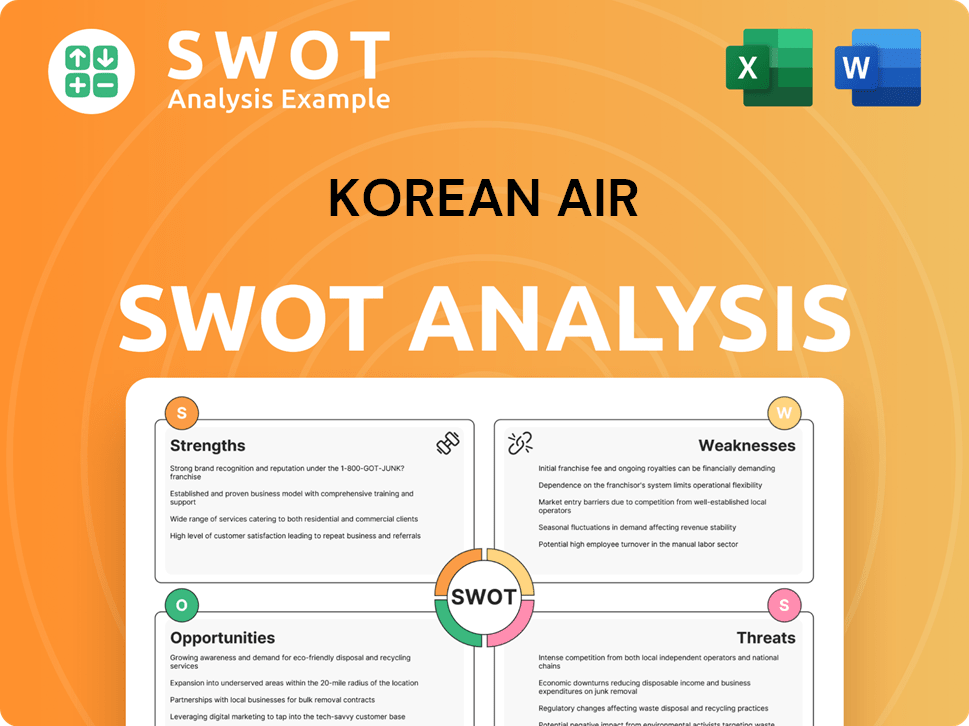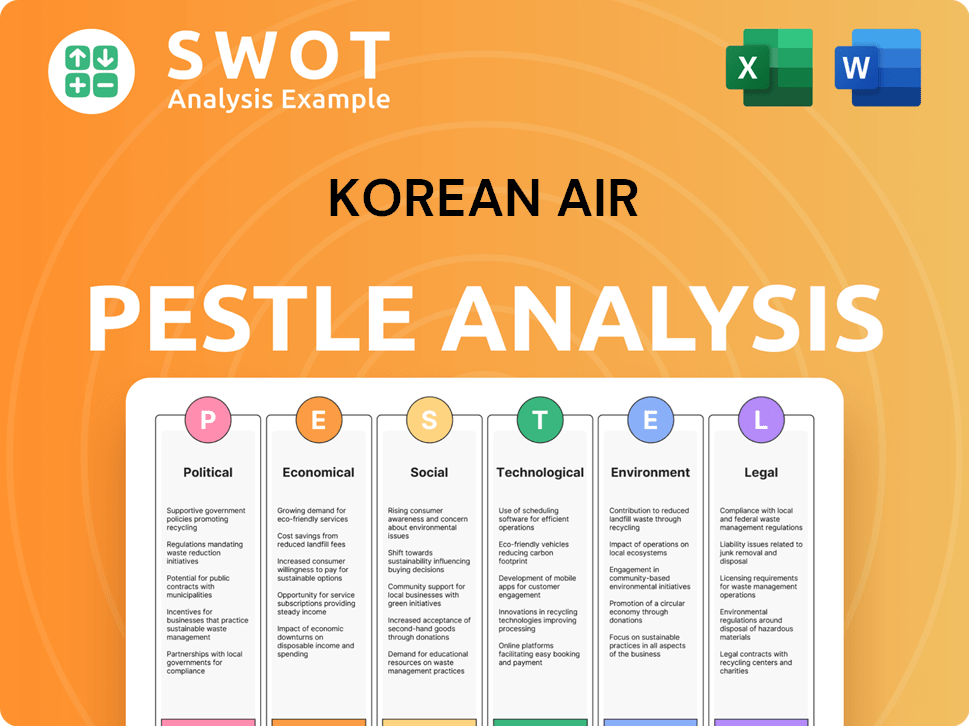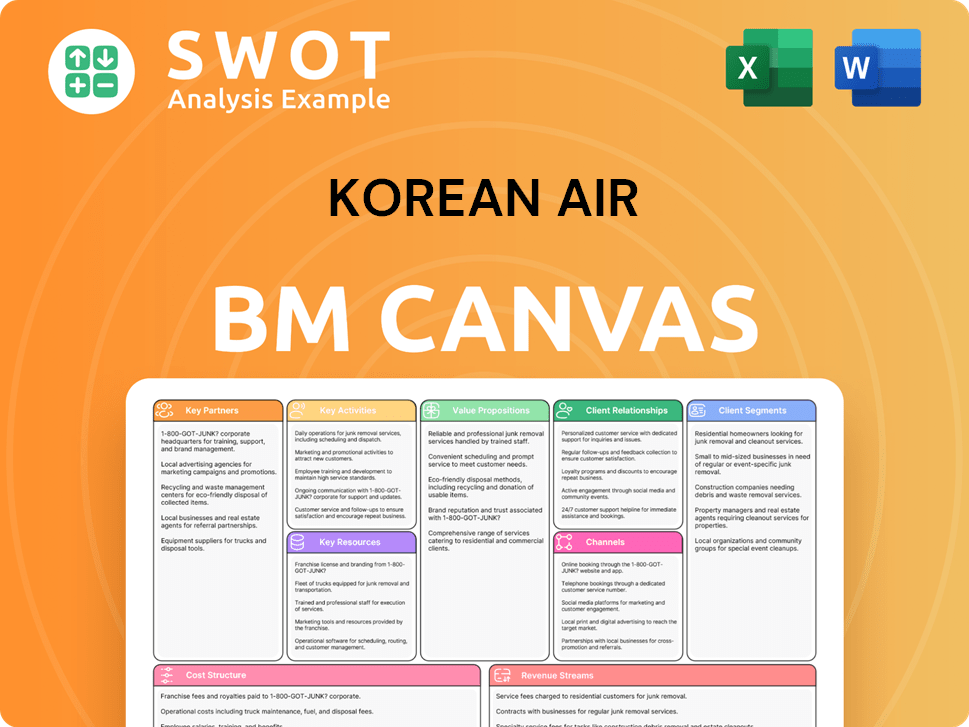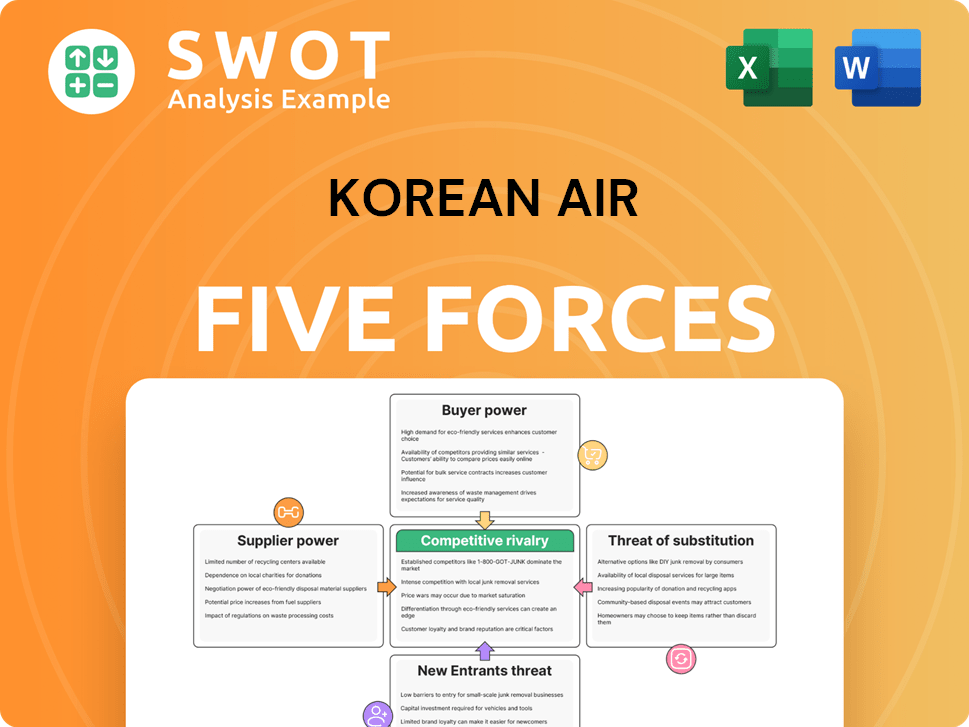Korean Air Bundle
How did Korean Air become a global aviation giant?
Embark on a journey through the Korean Air SWOT Analysis and discover the remarkable story of Korean Air, the flag carrier of South Korea, a company that has soared to international prominence. From its inception in 1969, when the Hanjin Group took the reins, to its current status as a leading global airline, Korean Air's history is a compelling narrative of strategic vision and unwavering determination. This article delves into the key milestones that have shaped this iconic Korean airline.

The brief history of Korean Air showcases its transformation from a fledgling national carrier to a major player in the aviation industry. The Korean Air company's expansion, marked by strategic decisions and a commitment to excellence, has seen it grow its Korean Air fleet and international routes. Today, Korean Air's destinations span across the globe, solidifying its impact on South Korea and its role in the aviation industry. Explore the Korean Air timeline and learn about its cargo operations and in-flight services.
What is the Korean Air Founding Story?
The story of Korean Air began on March 1, 1969. This marked the official founding when the Hanjin Group, under the leadership of Cho Choong-hoon, took over Korean National Airlines. Cho, a key figure in South Korean business, saw a chance to revamp the struggling national airline and build a strong air transport network, vital for South Korea's economic growth.
The initial challenge was the inefficiency and financial struggles of the state-run airline, which limited South Korea's global connections. Cho's vision was to transform this, setting the stage for Korean Air's future.
The original business plan included both passenger and cargo services, recognizing the increasing need for international trade and travel. Korean Air's first major purchase was a Boeing 707, showing its ambition to use modern jet aircraft. The early days saw Cho Choong-hoon's personal dedication and the difficulties of securing initial funding in a developing economy. This involved significant support from the government and private investment from the Hanjin Group. The name 'Korean Air' was selected to clearly identify it as the national flag carrier, fostering national pride and international recognition. The cultural and economic environment of post-war South Korea, with its focus on industrialization and global integration, greatly influenced the company's creation and its early focus on expanding international routes to support export-driven growth.
The founding of Korean Air was a strategic move to modernize and expand South Korea's air travel capabilities.
- Korean Air history began with the acquisition of Korean National Airlines by the Hanjin Group.
- Cho Choong-hoon's leadership was crucial in transforming the airline.
- The initial focus was on both passenger and cargo services to support international trade.
- Early challenges included securing funding and establishing international routes.
As of 2024, Korean Air operates a fleet of over 150 aircraft, serving numerous international destinations. The airline has significantly impacted South Korea's economy and its global presence. For more insights into the competitive landscape, you can read about the Competitors Landscape of Korean Air.
Korean Air SWOT Analysis
- Complete SWOT Breakdown
- Fully Customizable
- Editable in Excel & Word
- Professional Formatting
- Investor-Ready Format

What Drove the Early Growth of Korean Air?
The early growth of Korean Air, a significant player in the Korean airline industry, was marked by ambitious expansion and strategic fleet upgrades. In the early 1970s, the Korean Air company aggressively expanded its international routes, with the launch of services to Los Angeles in 1972, a pivotal move into the trans-Pacific market. This period also saw the introduction of larger aircraft, such as the Boeing 747 in 1973, which became central to its long-haul operations. This growth was driven by increasing demand for both passenger and cargo services, fueled by South Korea's rapidly growing economy and its rising presence in global trade.
Throughout the 1970s and 1980s, Korean Air continued to broaden its network across North America, Europe, and Southeast Asia. Key acquisitions of new aircraft models, like the Airbus A300 in 1975, further diversified its Korean Air fleet and enhanced its operational capabilities. The airline also invested in ground infrastructure, including maintenance facilities, to support its growing fleet. By the late 1980s, Korean Air had firmly established itself as a major international carrier, playing a vital role in connecting South Korea to the global economy.
Strategic decisions during this period included a strong focus on cargo operations, which proved to be a significant revenue stream, particularly with the growth of South Korea's export industries. Leadership transitions, including the continued involvement of the Cho family, ensured continuity in the company's long-term vision. The airline's expansion was also supported by the increasing demand for air travel, reflecting South Korea's growing economic prosperity and its integration into the global market. The Korean Air history is one of remarkable growth.
The 1970s and 1980s were characterized by aggressive fleet modernization, with the introduction of advanced aircraft that improved efficiency and passenger comfort. The expansion of international routes included services to major cities in Europe, North America, and Asia, solidifying its global presence. This period of growth was crucial for establishing Korean Air's brand and its role in the aviation industry. The Korean Air's expansion was a key factor.
The growth of the airline significantly impacted South Korea's economy by facilitating international trade and tourism. The increase in cargo services supported the export-oriented economy, while the expansion of passenger routes boosted tourism. The airline's success reflected and contributed to South Korea's rising global status. For more insights into the brief history of Korean Air, you can explore additional resources.
Korean Air PESTLE Analysis
- Covers All 6 PESTLE Categories
- No Research Needed – Save Hours of Work
- Built by Experts, Trusted by Consultants
- Instant Download, Ready to Use
- 100% Editable, Fully Customizable

What are the key Milestones in Korean Air history?
The Korean Air history is marked by significant achievements, innovations, and challenges that have shaped its trajectory in the aviation industry. From its humble beginnings to becoming a global player, the Korean airline has consistently adapted to the evolving landscape of air travel.
| Year | Milestone |
|---|---|
| 1969 | Founded as Korean Air Lines, initially operating with eight aircraft. |
| 1980s | Expanded its international routes, establishing itself as a major player in the Asia-Pacific region. |
| 2000 | Joined the SkyTeam airline alliance, enhancing its global network and passenger connectivity. |
| 2010s | Focused on fleet modernization, investing in fuel-efficient aircraft like the Boeing 787 Dreamliner. |
| 2020 | Significantly expanded cargo operations during the COVID-19 pandemic to mitigate financial losses. |
Innovation has been a core aspect of the
Investing in fuel-efficient aircraft, such as the Boeing 787 Dreamliner and Airbus A321neo, to reduce fuel consumption and emissions. The airline aims to enhance its environmental sustainability efforts.
Developing sophisticated maintenance and engineering services to ensure the safety and reliability of its fleet. This includes the implementation of predictive maintenance technologies.
Providing passengers with state-of-the-art in-flight entertainment systems, including a wide selection of movies, TV shows, and music. This enhances the overall passenger experience.
Implementing digital solutions for booking, check-in, and customer service to improve efficiency and enhance the customer experience. The airline is investing in mobile apps and online platforms.
Expanding its cargo operations with dedicated freighter aircraft to transport goods worldwide. This includes specialized services for temperature-sensitive cargo.
Focusing on sustainability by reducing carbon emissions and waste management. This includes the use of sustainable aviation fuel (SAF) and eco-friendly practices.
The
The Asian Financial Crisis in the late 1990s and the 2008 global financial crisis presented significant financial challenges. These events required strategic restructuring and cost-cutting measures to ensure survival.
Facing intense competition from other global carriers, particularly in the Asia-Pacific region. This competition necessitates continuous efforts to improve services and reduce costs.
Geopolitical events and travel restrictions, such as those during the COVID-19 pandemic, have significantly impacted passenger traffic. This has required the airline to adapt its strategies.
Fluctuations in fuel prices pose a constant challenge, affecting operational costs. The airline has implemented fuel-efficient measures and hedging strategies to mitigate the impact.
Managing labor relations and negotiating with unions can be a complex undertaking. The airline must ensure fair labor practices while maintaining operational efficiency.
Adapting to evolving aviation regulations and safety standards is an ongoing process. The airline must comply with international and local regulations to ensure passenger safety.
Korean Air Business Model Canvas
- Complete 9-Block Business Model Canvas
- Effortlessly Communicate Your Business Strategy
- Investor-Ready BMC Format
- 100% Editable and Customizable
- Clear and Structured Layout

What is the Timeline of Key Events for Korean Air?
The Korean Air company has a rich history, marked by significant milestones that have shaped its global presence in the aviation industry. From its inception in 1969 to its strategic moves in the 2020s, including navigating the COVID-19 pandemic and the planned acquisition of Asiana Airlines, the
| Year | Key Event |
|---|---|
| March 1, 1969 | Korean Air is established following the acquisition of Korean National Airlines by the Hanjin Group. |
| April 19, 1972 | Inaugural flight to Los Angeles, marking its first trans-Pacific service. |
| 1973 | Introduction of the first Boeing 747, expanding long-haul capabilities. |
| 1975 | Introduction of the Airbus A300, diversifying its fleet. |
| 1984 | Renamed from Korean Air Lines to Korean Air. |
| June 22, 2000 | Korean Air becomes a founding member of the SkyTeam airline alliance. |
| 2004 | Launches direct flights to Athens, Greece, expanding its European network. |
| 2010s | Significant fleet modernization with the introduction of Boeing 787 Dreamliners and Airbus A380s. |
| 2020-2022 | Navigates the COVID-19 pandemic by significantly expanding cargo operations. |
| 2021 | Announces plans to acquire Asiana Airlines, aiming to create a stronger global aviation player. |
| 22 February 2024 | European Commission approves Korean Air's acquisition of Asiana Airlines, subject to conditions. |
| May 2024 | Korean Air reports a strong first-quarter performance, driven by robust cargo demand and recovering passenger traffic. |
The acquisition of Asiana Airlines is a pivotal move for Korean Air, set to create one of the world's top ten airlines. This merger is expected to enhance network competitiveness and operational efficiency. The combined entity will have a stronger presence in key markets and offer a more comprehensive route network, bolstering the
Korean Air is actively focusing on sustainability, including investments in sustainable aviation fuel (SAF) and fleet modernization. These initiatives aim to reduce emissions and align with global environmental trends. The airline's commitment to sustainability reflects its long-term vision for responsible growth and environmental stewardship within the aviation industry.
The airline anticipates a continued recovery in international passenger demand in 2025, while maintaining a strong cargo business. This dual focus highlights Korean Air's ability to adapt to market dynamics and capitalize on opportunities. The strategic balance between passenger and cargo operations is key to its financial performance.
Leadership emphasizes a commitment to innovation, customer experience, and maintaining its position as a leading global airline. This focus underscores the airline's dedication to providing superior services and staying ahead in a competitive industry. The company is building upon its founding vision of connecting Korea to the world.
Korean Air Porter's Five Forces Analysis
- Covers All 5 Competitive Forces in Detail
- Structured for Consultants, Students, and Founders
- 100% Editable in Microsoft Word & Excel
- Instant Digital Download – Use Immediately
- Compatible with Mac & PC – Fully Unlocked

Related Blogs
- What is Competitive Landscape of Korean Air Company?
- What is Growth Strategy and Future Prospects of Korean Air Company?
- How Does Korean Air Company Work?
- What is Sales and Marketing Strategy of Korean Air Company?
- What is Brief History of Korean Air Company?
- Who Owns Korean Air Company?
- What is Customer Demographics and Target Market of Korean Air Company?
Disclaimer
All information, articles, and product details provided on this website are for general informational and educational purposes only. We do not claim any ownership over, nor do we intend to infringe upon, any trademarks, copyrights, logos, brand names, or other intellectual property mentioned or depicted on this site. Such intellectual property remains the property of its respective owners, and any references here are made solely for identification or informational purposes, without implying any affiliation, endorsement, or partnership.
We make no representations or warranties, express or implied, regarding the accuracy, completeness, or suitability of any content or products presented. Nothing on this website should be construed as legal, tax, investment, financial, medical, or other professional advice. In addition, no part of this site—including articles or product references—constitutes a solicitation, recommendation, endorsement, advertisement, or offer to buy or sell any securities, franchises, or other financial instruments, particularly in jurisdictions where such activity would be unlawful.
All content is of a general nature and may not address the specific circumstances of any individual or entity. It is not a substitute for professional advice or services. Any actions you take based on the information provided here are strictly at your own risk. You accept full responsibility for any decisions or outcomes arising from your use of this website and agree to release us from any liability in connection with your use of, or reliance upon, the content or products found herein.